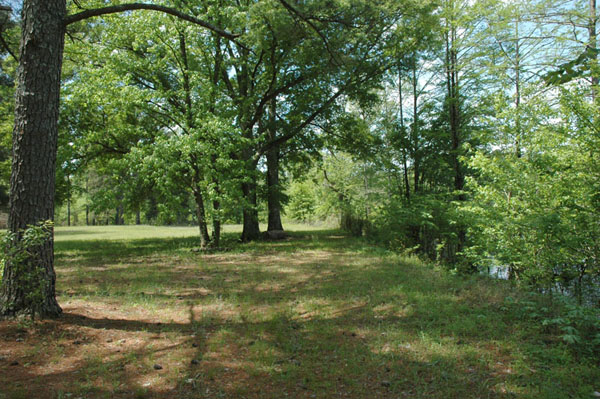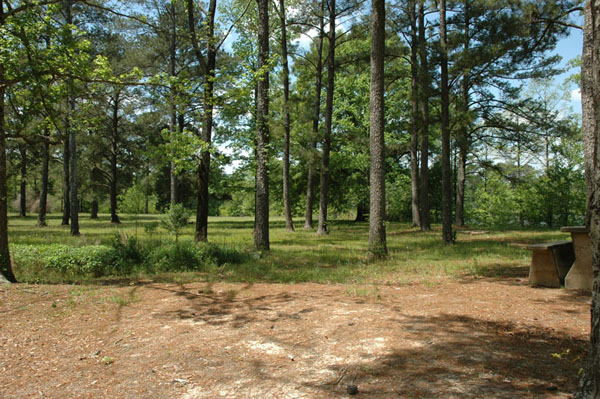Ants in Disturbed Mixed Pine/Hardwood Areas near headquarters, other buildings, and picnic areas of Noxubee National Wildlife Refuge, Mississippi
Joe A. MacGown and JoVonn G. Hill
Click links to view ants in the primary habitat types at the Noxubee National Wildlife Refuge.
[Noxubee Ants-all habitats] [pine forests] [pine/hardwood forests] [bottomland hardwood forests] [upland hardwood forests] [fields, grasslands, & other open areas] [disturbed wooded areas]
A recent project was undertaken by the MEM to survey the Noxubee National Wildlife Refuge in Oktibbeha, Noxubee, and Winston Counties for ants. The refuge owns approximately 48,000 acres, which can be separated into three primary habitats: forests, fields and grasslands, and wetlands. By far, forests form the majority of the refuge and cover about 45,000 acres (about 93%). The forests can be further divided into four major types including pine (23,619 acres), mixed pine/hardwood (2,851 acres), bottomland hardwood (15,453 acres), and upland hardwood (3,263 acres). In this study we examined six terrestrial habitat types to determine species compositions for each habitat. Habitat types for this study included pine forests (both mature and young forests, and recently burned or unburned); bottomland hardwood forests (including cypress dominanted areas); upland hardwood forests; mixed pine/hardwood forests (including one area intermixed with cedar); open habitats including fields, grasslands, roadsides, and a sand pit; and disturbed, open mixed forests located near buildings and picnic areas. The latter disturbed sites were included because of their likelihood of being ideal habitats for various exotic species. In addition to the ants collected during this survey, the total list of species from the refuge includes earlier records of ants collected by the Mississippi Entomological Museum (MEM). Collecting methods included baiting, beating and sweeping vegetation, litter sampling, and visually searching for ants and their colonies. Our collections have revealed a diverse fauna, and we have collected 98 species (species list) at the refuge.
Although open disturbed forested habitat near buildings and picnic areas at the Noxubee NWR comprises a very small percentage of the total land mass, we included it in this study because this type of habitat often harbors various exotic species that may be lacking or found in reduced numbers in surrounding natural areas. Sites included in this category were the areas immediately surrounding the headquarters at Bluff Lake, the Education Center and Pavilion near Loakfoma Lake, and the refuge housing area near Bluff Lake. These sites included a mix of pines and other hardwoods, with unnaturally opened understories created by mowing, and with ornamental plantings and mulched areas. Our expectations of finding exotic ant species at these sites were realized, as we found several introduced species including Linepithema humile (Argentine ant), Brachymyrmex patagonicus (dark rover ant), Nylanderia vividula (some researchers do not consider this species to be exotic), Strumigenys membranifera , and Solenopsis invicta x richteri (imported fire ant hybrid). In some regards, we would consider the Argentine and the rover ants to be the most problematic of these species because they have the potential to build huge populations with mulitiple queens. These two species were likely introduced to the refuge in hardwood or pine mulch, potting soil, or in ornamental plants. At the time of this study these two species were only found in reduced numbers, and therefore, were probably only recently introduced. The somewhat unnatural openings beneath trees with various bare spots of soil actually created some ideal nesting sites for several native species, which were not found or where only found in reduced numbers elsewhere at the refuge. The genus Pheidole seemed to especially benefit from this habitat and we found three species, including one undescribed species in the crassicornis group, nesting in these openings beneath trees. Another isolated group of trees located next to the pavilion at the Education Center had various pieces of old trash present (i.e. bottles, cans, wire, etc.), but also had several interesting ant species present including the rarely collected Strumigenys metazytes, which was ony recently reported from Mississippi. So, on one hand, the manmade disturbances have created ideal habitat for some exotic species, but on the other hand, habitat was opened up for various native species. Thus far, 38 species have been collected at the disturbed wooded sites (see species list below).
 |
 |
Disturbed, open, pine/hardwood habitat near the headquarters. This area is occasionally mowed and has no understory and some open bare areas. |
Another shot of the open pine/hardwood habitat near the headquarter, showing a bare spot near a picnic table. |
List of the Ants from disturbed, open Pine/hardwood areas near the headquarters, other buildings, and picnic areas at the Noxubee National Wildlife Refuge
(Species are arranged alphabetically by genus)
Aphaenogaster carolinensis Wheeler [litter-Carya base near pavilion]
Aphaenogaster fulva Roger [litter-Carya base near pavilion]
Aphaenogaster lamellidens Mayr
Aphaenogaster treatae Forel [colony in soil]
Brachymyrmex depilis Emery [in litter & mulch near HQ]
Brachymyrmex patagonicus Mayr (introduced, pest) [in litter & mulch near HQ]
Camponotus castaneus (Latreille) (pest)
Camponotus chromaiodes Bolton (pest)
Camponotus pennsylvanicus (DeGeer) (pest) [on ground & trees]
Camponotus snellingi Bolton (pest)
Crematogaster ashmeadi Mayr (pest) [colonies under bark in trees]
Discothyrea testacea Roger [in litter, mulch]
Forelius mccooki (McCook) [along edges of parking areas and walkways]
Formica pallidefulva Latreille
Hypoponera opaciceps (Mayr) (introduced) [in litter]
Hypoponera opacior (Forel) [in litter, mulch]
Linepithema humile (Mayr) (introduced, pest) [in litter & mulch near HQ]
Monomorium minimum (Buckley) (pest) [colonies in soil]
Myrmecina americana Emery [litter]
Nylanderia arenivaga (Wheeler) [found in soil in open bare spots nr. HQ]
Nylanderia faisonensis (Forel) [litter-tree bases]
Nylanderia vividula (Nylander) (introduced?, pest) [soil & litter in landscaped area]
Pheidole bicarinata Mayr (pest?) [found in soil in open bare spots nr. HQ]
Pheidole (crassicornis group) sp.-01 [found in soil in open bare spots nr. HQ]
Pheidole dentata Mayr (pest?) [on ground]
Pheidole dentigula Smith [litter-Carya base near pavilion]
Pheidole metallescens Emery [soil-Carya base near pavilion]
Pheidole tysoni Forel [colonies in soil in open bare spots nr. HQ]
Ponera pennsylvanica Buckley [in litter, mulch]
Prenolepis imparis (Say) [open wooded park-like area]
Solenopsis carolinensis Forel ?? (appears to be this species) [litter & soil]
Solenopsis invicta x richteri (introduced, pest) [colonies in soil]
Strumigenys louisianae Roger [litter-Carya base near pavilion; soil & litter in landscaped area]
Strumigenys membranifera Emery (introduced) [litter/mulch near HQ]
Strumigenys metazytes (Bolton) [litter-Carya base near pavilion]
Temnothorax curvispinosus (Mayr) [litter, hollow twigs, etc. at tree bases]
Temnothorax schaumii (Roger) [colonies under bark in trees]
Trachymyrmex septentrionalis (McCook)
Links
MacGown, J. A., J. G. Hill, T. L. Schiefer, and R. L. Brown. 2012. Ant diversity and habitat associations at the Noxubee National Wildlife Refuge in Mississippi. Mississippi Agricultural and Forestry Experiment Station Technical Bulletin 1197. [pdf]
Landmarks article about the Noxubee Study [pdf]
Noxubee National Wildlife Refuge [http://www.fws.gov/noxubee/]


